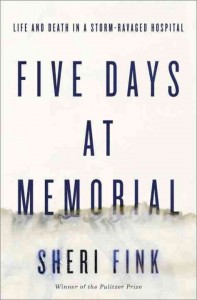Five Days at Memorial
Written by Ashley Kelmore, Posted in Reviews
I’m doing it again! Off we go for Cannonball Read 6 …
If you’ve read my previous reviews, you might recall that I work in emergency preparedness. This book was on my radar for 2014, and was lent to me by a coworker before I left work on New Year’s Eve. I spent most of my day off yesterday reading it, and finished it up walking to work and on my lunch break today. The book is nearly 500 pages long, so that should tell you about the quality of the writing. Five Days at Memorial is a fantastic book, and one that I would recommend to anyone interested in Hurricane Katrina, medical ethics, or just great investigative journalism.
The book is broken into two parts: a description of the eponymous situation, which took place during and immediately after Hurricane Katrina at a private hospital in New Orleans, and the investigation into the actions of some of the doctors (one in particular) and the nurses involved. It also raises two separate but related questions: what is appropriate for clinicians to do when faced with disastrous circumstances in a healthcare facility, and is what the doctor and nurses are alleged to have done at Memorial in line with that? Finally, another issue of interest that gets mentioned but is not the focus of the book is the responsibility of hospitals and the state have to be prepared for foreseeable disasters such as Hurricane Katrina.
The basic situation at Memorial was similar to one facing many hospitals in 2005 (and, as shown with NYU Langione during Hurricane Sandy, was still an issue in 2012): the generator and many necessary electrical switches of the major hospital were in the basement or ground floor of the building and thus susceptible to flooding. When the levees stopped functioning the days after Hurricane Katrina came and went, the flooding reached Memorial and resulted in a generator that ultimately petered out. That, coupled with the inability to quickly evacuate patients, meant that the clinicians, patients, and other family members at the hospital faced very unpleasant circumstance. By the time everyone was evacuated, many patients had died, including many who died in a three hour period on the last day.
The writing, the research, and the story Ms. Fink weaves together is gripping. It’s heartbreaking, and as someone who works in emergency management, it is one of my worst fears. The lack of planning, the lack of preparation, the lack of support from the parent company, it all is just devastating and infuriating. And yet … the hospital never ran out of food, or water. Clinicians were, for the most part, able to do amazing things in an utterly foul situation. But the big question around why did so many patients die on that last day, and whether Dr. Pou made the decision to help death along for those patients, is the focus. And while Dr. Pou makes public statements about doing ‘what she had to do,’ my take-away from this book is that while there certainly are times when this might be true, this specific instance, at this hospital, was not a situation where that statement needed to be made so far as euthanasia is concerned.
Dr. Pou seems sketchy, and seemed to make HER case be about a hypothetical situation that she was never really facing (and would not reasonably have thought she was facing), but that she spoke of as if she had indeed experienced it. Based on my reading of this book, what Dr. Pou chose to do to those patients is not an example of making decisions in a no-win situation. Not to spoil it (and stop here if you plan to read the book and are not familiar with the story), but on that last day, the helicopters were there, and those patients could have been evacuated. They weren’t definitely going to die, and Dr. Pou acted as though they were. That seems to be her defense. And while it’s a defense worth interrogating for real situations where the options are death in tons of pain in a day or death easily now, those weren’t the choices facing those patients that day.
As someone interested in medical ethics, I found the discussion of these issues to be well done. The topics of rationing medical care in an emergency, of deciding who should receive treatment first, and who should wait, are issues that need to be resolved. The clinical community is aware of this and is working on it. Hopefully books like this will make the issue more salient in the rest of the community as well.
Five stars.

